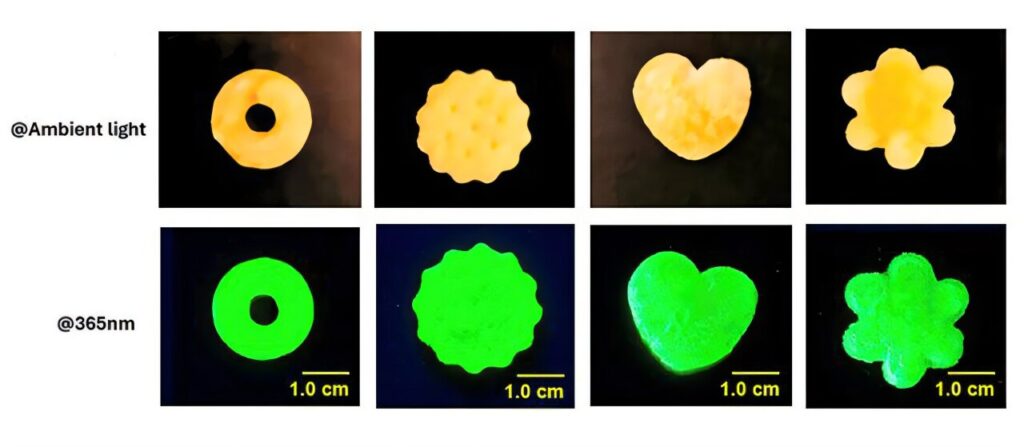Every day, people are reaping the benefits of work by scientists and engineers to make more effective X-ray machines, computers, cell phones and televisions. Florida State University researchers are pushing the boundaries of those technologies and developing new more cost-effective and environmentally friendly materials for these devices.
FSU Professor of Chemistry and Biochemistry Biwu Ma and his lab have spent years pioneering the use of hybrid materials known as organic metal halide hybrids, or OMHHs. These materials combine organic molecules with metal halide units, resulting in structures with easily manipulated properties that are used in solar cells, light-emitting diodes (LEDs) and more. This fall, their work related to various aspects of these materials was published in three different scientific journals.
“Our group is widely recognized as a pioneer in the development of this new class of hybrid materials known as organic metal halide hybrids, or OMHHs,” Ma said. “What’s fascinating about these materials is their exceptional structure and property tunability—much like assembling Lego pieces, we can combine organic and metal halide building blocks in countless ways to produce materials with all kinds of functionalities for use in various industries.”
In an article published in Advanced Materials in November, Ma’s team demonstrated how zero-dimensional, or 0D, OMHHs serve as light-emitting materials when combined with metal halide perovskites, producing high-performance white LEDs. The researchers stacked two emissive layers of materials—one emitting blue light and the other emitting orange and red light—to generate white light.
In addition to turning electricity into visible lights in LEDs, 0D OMHHs can also convert high-energy radiation, like X-ray radiation, into visible light. This makes them ideal for use in X-ray scintillators, which play a critical role in medical imaging, security screening and industrial chemical testing. Scintillators, which allow imaging of teeth at the dentist or luggage at airport security, among other uses, are traditionally made from inorganic materials that require costly, high-temperature and high-pressure manufacturing.
As the first research group to report the use of low-cost, eco-friendly 0D OMHHs for X-ray scintillators in 2020, Ma’s group has been at the forefront of advancing this technology. The team’s work on LEDs has received continuous support from the National Science Foundation over the years, producing more than a dozen high-profile publications and graduating multiple doctoral students.
“Biwu is a high-impact chemist, and what he’s accomplished in his career so far is amazing,” said Wei Yang, Department of Chemistry and Biochemistry chair. “He’s world-renowned not only for designing materials with ‘dream’ properties but also for developing novel concepts and guiding the field of materials design with his work.”

In another study, published in Advanced Functional Materials in September, Ma and his team described how a new form of 0D OMHHs, solution processed amorphous films, can be used to produce large area X-ray scintillators. Prior to this work, nearly all 0D OMHH-based X-ray scintillators relied on solution-grown single crystals, which require time-intensive synthesis and are constrained by size limitations. Ma’s team leveraged the amorphous nature of OMHHs, facilitating the creation of high-performance, solution-processable scintillators.
The team is collaborating with multiple research institutions to explore applications in radiation therapy and photon-counting computed tomography, a radiology technique. They’re also working with industrial collaborators to commercialize 0D OMHH-based scintillators, which can be produced cost-effectively using Earth-abundant, non-toxic raw materials.
“Biwu is unusually creative—his ideas are embedded with exceptional insights,” Yang said. “His students say that while Biwu’s ideas seem unbelievable at first, they always work so well. The department has put tremendous effort into faculty development and observed the growth of incredible scientists to become forefront scholars in their respective research areas, and Biwu is a shining example.”
In an article from ACS Energy Letters published in November, Ma’s team collaborated with researchers from Los Alamos National Laboratory and the University at Buffalo to explore the application of 0D OMHHs in direct X-ray detectors that convert X-rays into electrical signals.
Direct X-ray detectors, widely used in medical imaging and security screening, traditionally employ materials like silicon and selenium that come with limitations in performance, adaptability and cost. While materials like metal halide perovskites have garnered attention for their potential to enhance X-ray detection, instability and toxicity remain significant barriers to widespread adoption.
The team demonstrated that 0D OMHHs provide an eco-friendly, low-cost alternative with advantages including high-sensitivity, low detection limits and solid stability, making the materials a promising option for a range of applications from medical diagnostics and imaging to security and scientific research. Ma filed a U.S. patent application for these OMHH-based direct X-ray detectors, and the team is seeking grant support with their collaborators to further advance this technology.
“Since our first paper on these materials in 2017, we’ve continuously explored new compositions, structures, properties, functionalities and applications, and our work spans a broad spectrum,” Ma said. “We see 0D OMHHs as an incredibly versatile material platform with the tremendous potential to outperform existing materials in numerous applications.”


